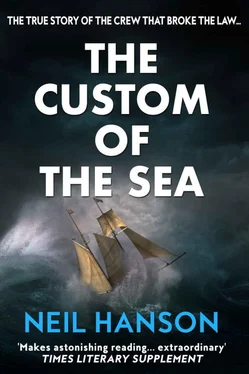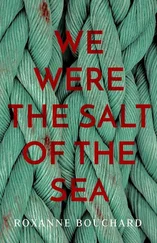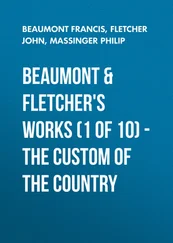Captain Simonsen had also been summoned to make a statement. In turn, each man was called into the Long Room of the Customs House, and questioned by Robert Cheesman, the local shipping master, receiver of wrecks, collector of customs and superintendent of the Mercantile Marine Office. A clerk laboriously recorded their statements.
Sergeant Laverty was also present, but though the statements were compulsory, their function was to help increase safety at sea, not to provide police evidence for criminal proceedings.
Asked about the loss of the Mignonette , Tom came close to an open admission that she had been too old for such a voyage. ‘At the time of sailing, the ship was tight, staunch and in every way fit for the voyage. She had two pumps in good working order, worked by hand. The only thing I can say to account for the accident is that the Mignonette was rather aged to make the passage. But we proved she was a good sea boat, and had she been a new boat, I feel sure we should have made the passage in perfect safety, if only putting up with a little discomfort.’
In another written statement prepared for the Mignonette’s owner, Jack Want, but later deleted by Tom after second thoughts, he appeared to blame the ‘stiffness’ of the Mignonette , caused by the tons of lead carried on its keel and the water butts and other cargo stowed amidships. ‘I myself felt when the sea was on the quarter just as if the after end was being knocked away from the solid weight which would now allow the frames to spring as if something bound her amidships.’
Dick Fox, the shipwright at Fay’s Yard, later confided to a young apprentice, Vernon Cole, that the Mignonette had sunk when the hood ends of the garboard strakes, which fitted into notches in the stern of the ship, had sprung.
Fox had repaired the Mignonette by screwing the garboard strakes into the stem, even though he had noticed that the deadwood of the stem had been ‘a little sick’. He said that, ever since then, he always drilled right through from one side of a yacht’s stern to the other and used copper rods flanged at both ends to secure the garboard strakes.
According to Vernon Cole, he repeated on several occasions, ‘I’m sure I did everything right,’ an assertion at least partly contradicted by his change of technique, but if blame is to be apportioned for the loss of the yacht, others must share it. Jack Want and Andrew Thompson recruited Tom Dudley to sail an elderly and infirm yacht through some of the most violent oceans on the planet, and Tom himself insisted that the repairs were carried out with recycled wood rather than new.
However, the freak wave remained the major cause of the sinking. Tom, Brooks and Stephens all said that they had never seen a bigger wave and far newer, larger and stronger ships than the Mignonette had been sent to the bottom by rogue waves.
The brief statements before the shipping master were soon concluded. The ship’s loss was formally attributed to ‘stress of weather’ — the standard description for a loss caused by a storm or other natural hazard — and Richard Parker’s death certificate recorded the cause of his demise as ‘killed’.
Cheesman spent some time talking to Tom in the Long Room after he had given his statement. He showed a prurient curiosity in the death of Richard Parker, but his tone was friendly and his only apparent concern was the well-being of Tom and his crew.
‘How did you kill the boy?’ he said.
Tom described the events, even lying down on the floor to show how Richard had been curled up in the bottom of the boat. He then pulled the knife from his pocket and showed Cheesman how he had used it to cut Richard’s throat.
Sergeant Laverty was still present, listening to the exchanges. He held out his hand. ‘Be kind enough to give the knife to me.’
‘I should not want to lose it,’ Tom said. ‘I want it as a keepsake.’
Laverty nodded, his hand still extended. ‘And you will have it back on some future occasion.’
Tom handed it over and Laverty immediately left the Customs House. After he had gone, Tom passed Cheesman a sheaf of papers, written in his cramped, painstaking hand. ‘While I was aboard the Moctezuma , I also made a record of the sinking of the Mignonette , and of our time aboard the dinghy. I thought to forward it to the ship’s owner, Mr Want, in Sydney, but perhaps you first wish to examine it?’
‘I shall send it to the Board of Trade with the other documents,’ Cheesman said, ‘with the request that it be returned to you once the formalities are completed. As you may know, I am required to file a report to the board after any death at sea, but it is usually a matter of routine.
‘The board has the power to hold a formal wreck inquiry and even strip an errant ship’s officers of their certificates of competence, but such a course of action is usually followed only if passengers have died. I imagine that they will not regard the loss of one seaman aboard a small vessel like the Mignonette as worthy of any official comment.
‘I will cable the Board of Trade for instructions at once. You can return to the Sailors’ Home, but do not leave Falmouth until I have had some reply from London. I hope that you will be free to return to your homes later today.’ He shook their hands in turn. ‘You have my sympathy, you have endured a terrible ordeal.’
They bade an emotional farewell to Captain Simonsen outside the Customs House. ‘Captain,’ Tom said, ‘without the gentle care of yourself and your wife we should surely have perished, even after our rescue. Words are not enough to thank you.’ His eyes filled with tears as he spoke. ‘The only thing that troubles me now is how we can repay you for the kindnesses you have given us. In due course we will present you with something that will ever keep the sufferers of the Mignonette in your memory, but we owe you our lives, and that is a debt that can never be repaid. I hope we may meet again one day and may God forbid that either you or any of our brother seamen ever have to go through the hardships we poor souls did.’
The two men embraced, then Simonsen turned and walked away towards the waterfront.
On their way back across Falmouth to the Sailors Home, Tom stopped to cable his wife again. ‘AM HERE AND AS WELL AS CAN BE EXPECTED. HOPE TO BE ENABLED TO FINISH WORK AND LEAVE FOR HOME TONIGHT.’
* * *
At twelve fifty-six, a few minutes after Tom had left the Customs House, Cheesman sent a telegram to the Marine Department of the Board of Trade, copied to the Registrar-General of Shipping:
SURVIVORS OF WRECK OF YACHT MIGNONETTE OF SOUTHAMPTON BROUGHT HERE BY GERMAN BARQUE MOCTEZUMA , PICKED UP IN LATITUDE 24.28 SOUTH AND LONGITUDE 27.22 WEST. AFTER HAVING BEEN IN OPEN BOAT FOR TWENTY FOUR DAYS AND ONLY TWO ONE POUND TINS OF TURNIPS, NO WATER, RICHARD PARKER, BOY, KILLED ON TWENTIETH DAY BY THOMAS DUDLEY, MASTER, WHO HOLDS MATE’S CERTIFICATE, TO SUSTAIN SURVIVORS’ LIVES. I AM TAKING STATEMENTS FOR BOARD OF TRADE. NUMBER OF CAPTAIN DUDLEY’S CERTIFICATE UNKNOWN. BOY WAS KILLED 25TH JULY. A COPY OF THIS TELEGRAM SENT TO THE ASSISTANT SECRETARY, MARINE DEPARTMENT, BOARD OF TRADE. SHOULD THE SURVIVORS BE DETAINED FOR INQUIRY? PLEASE TELEGRAPH IF I MUST APPLY TO POLICE.
Having fulfilled his statutory duty, Cheesman strode off to his club for his customary hearty lunch. James Laverty had no appetite for his own more frugal repast. He had gone straight from the Customs House to the clerk to the justices, John Genn, to obtain a warrant for the three men’s arrest, but Genn would not act without the authority of Henry Liddicoat, the chairman of the borough magistrates, and Liddicoat, who was also mayor of Falmouth and a local shopkeeper, was politically astute enough to know where sympathies lay in the town.
Читать дальше











